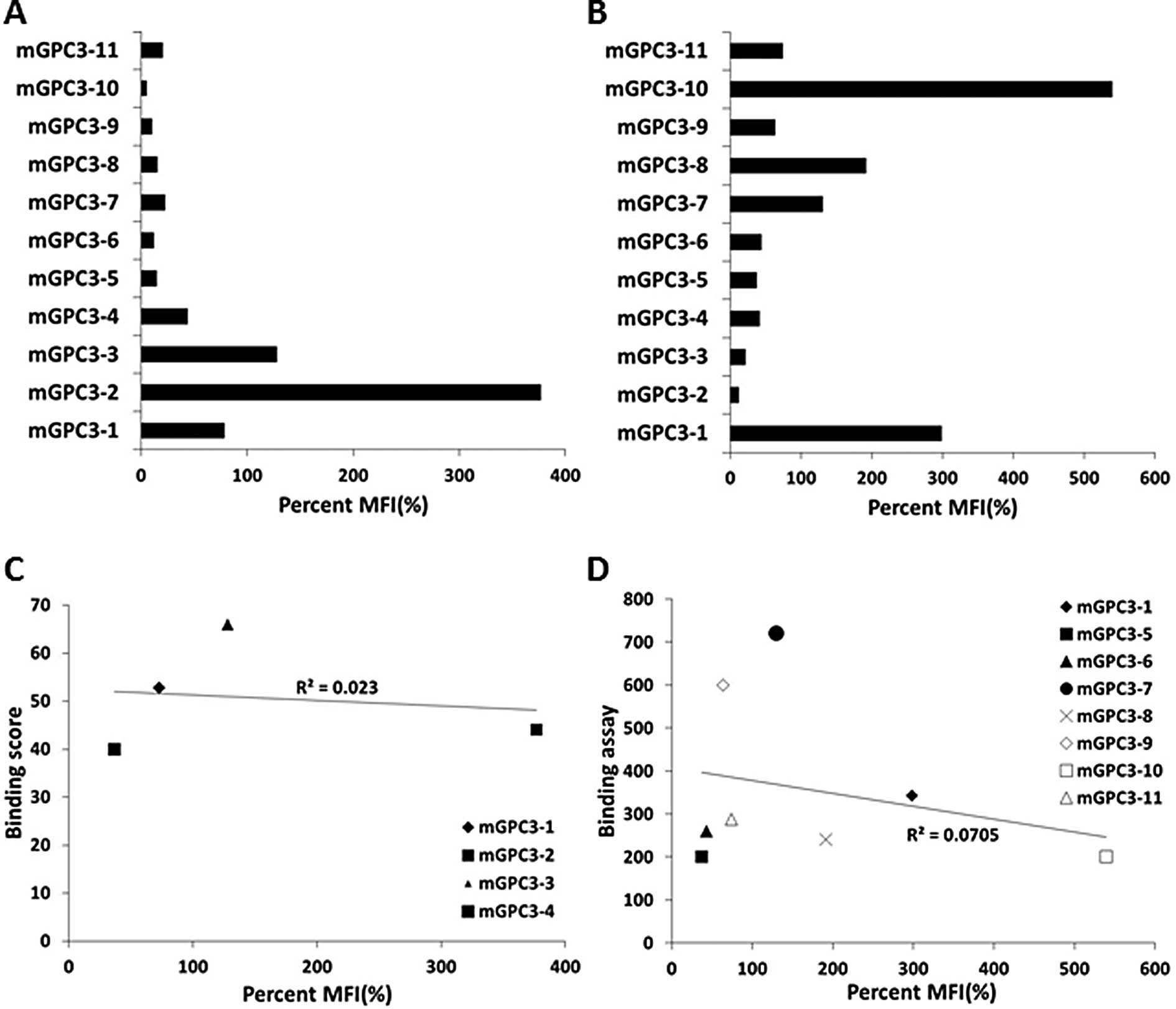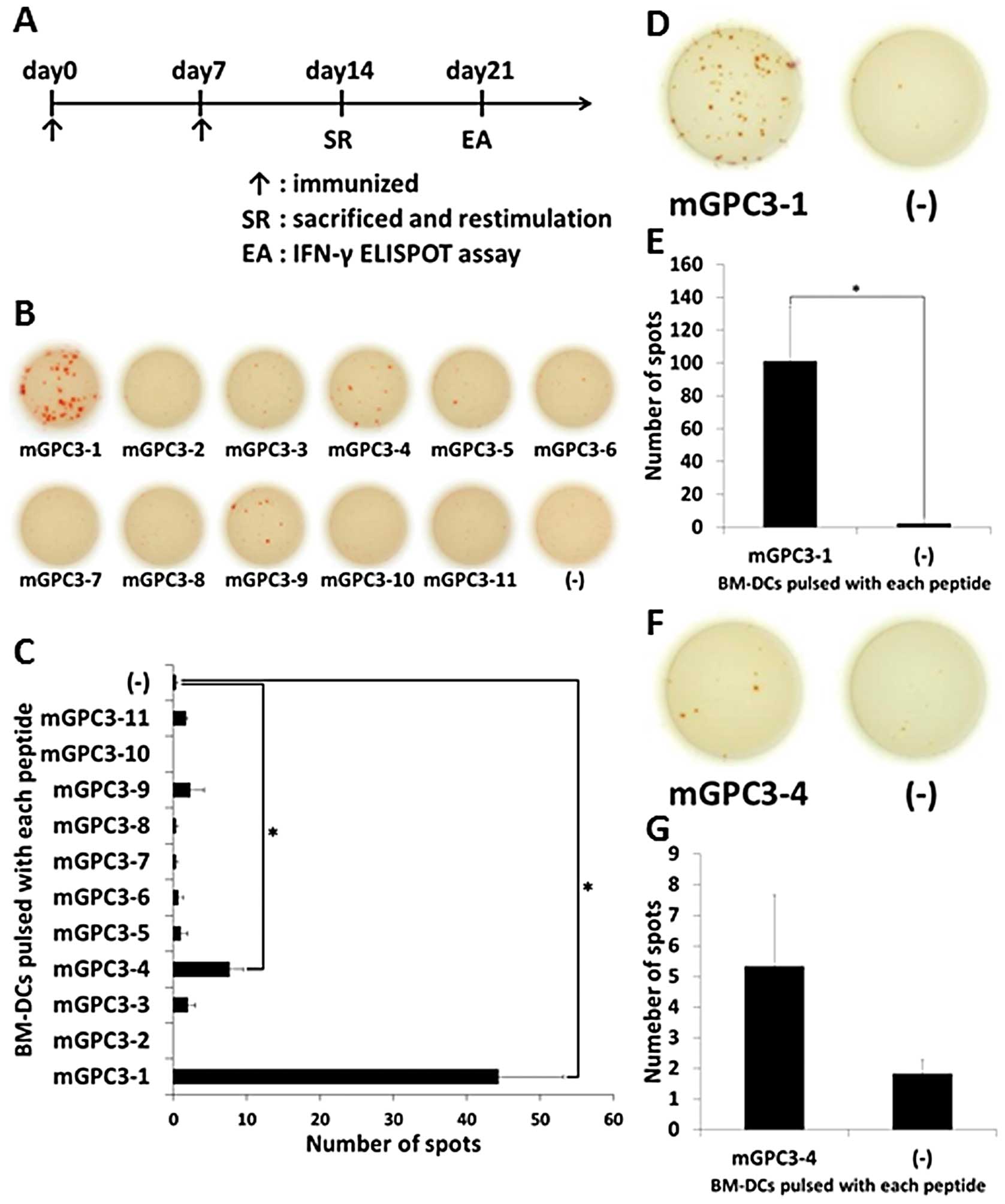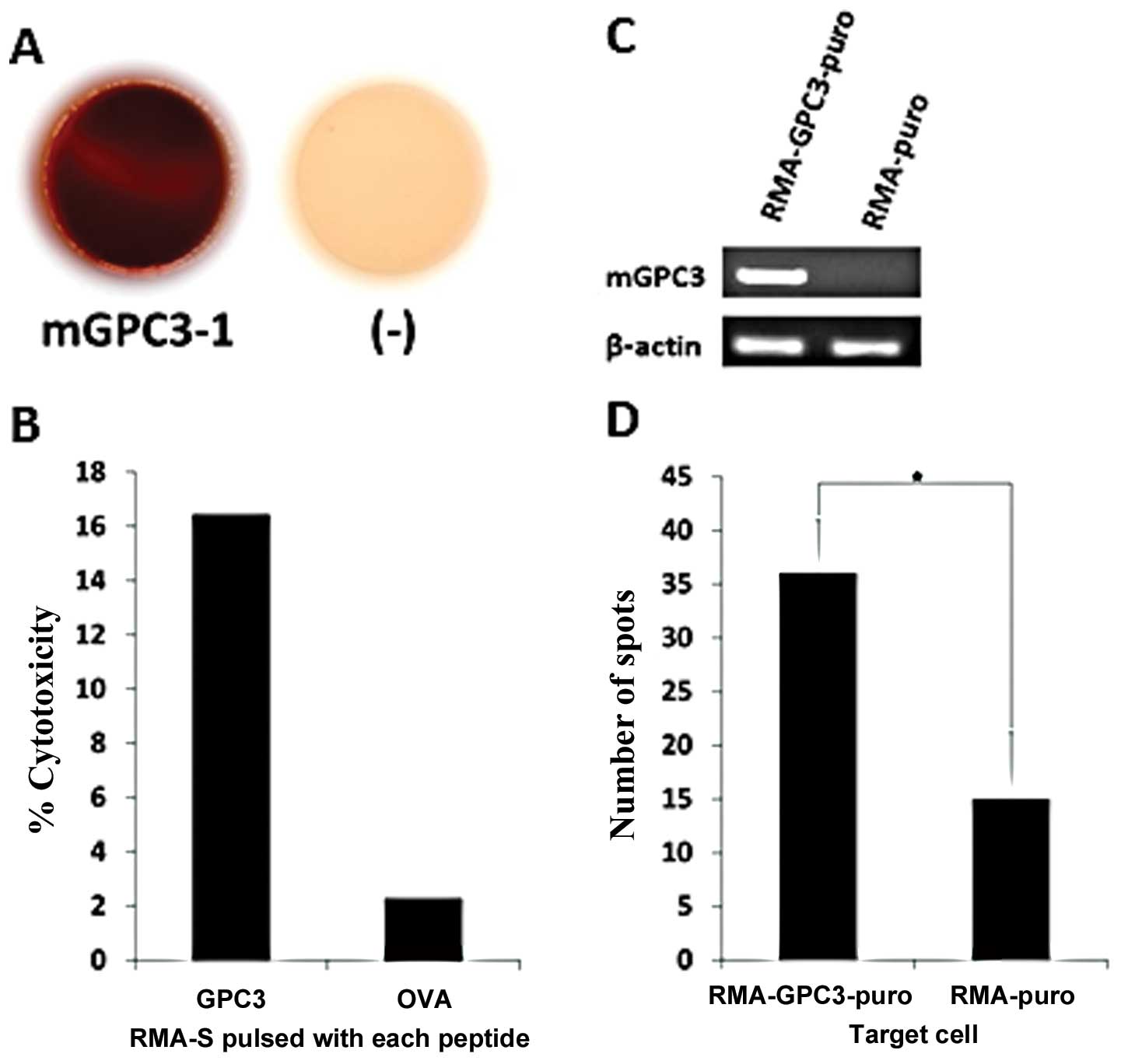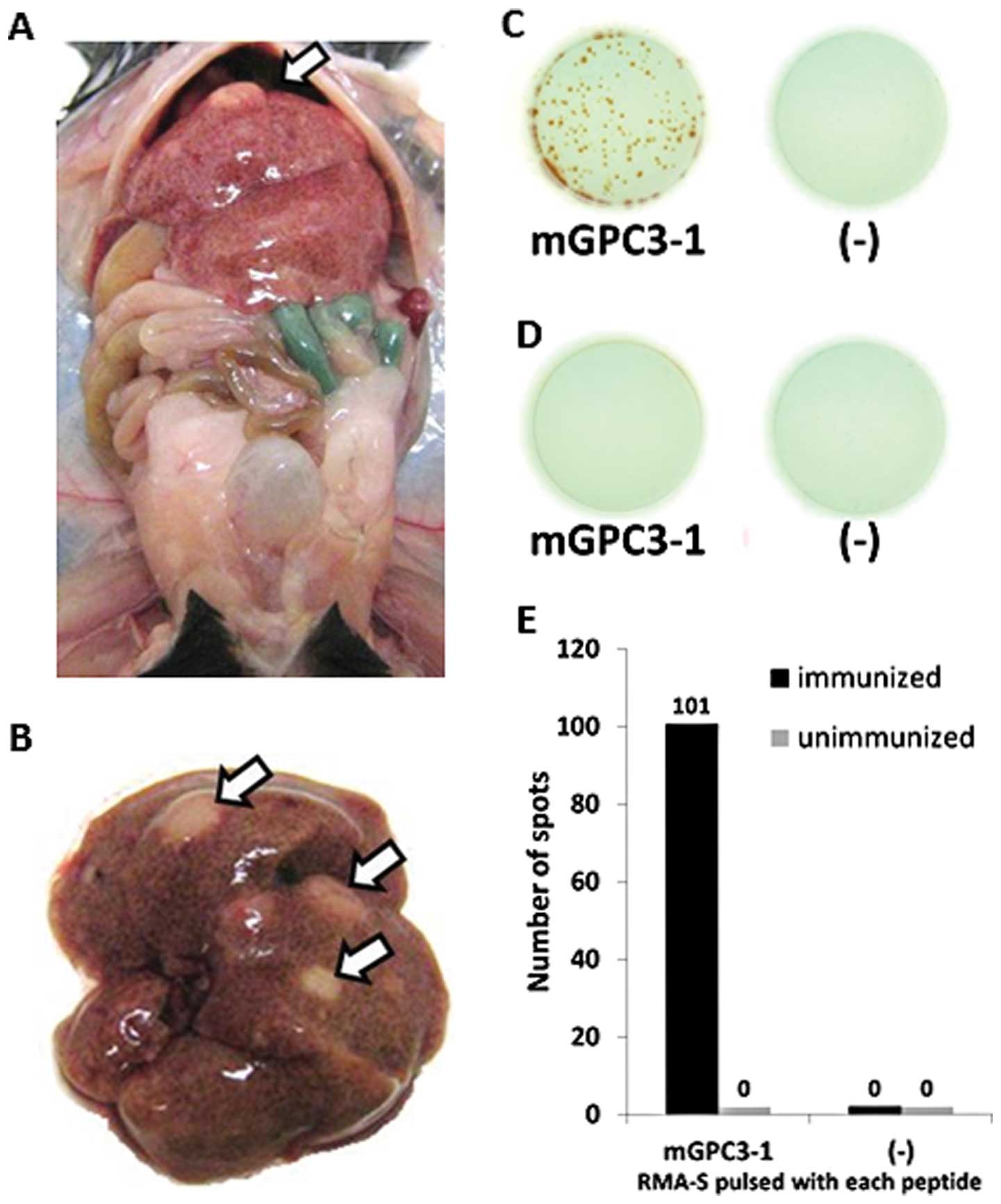|
1
|
Jemal A, Bray F, Center MM, Ferlay J, Ward
E and Forman D: Global cancer statistics. CA Cancer J Clin.
61:69–90. 2011. View Article : Google Scholar
|
|
2
|
Yamamoto J, Okada S, Shimada K, et al:
Treatment strategy for small hepatocellular carcinoma: comparison
of long-term results after percutaneous ethanol injection therapy
and surgical resection. Hepatology. 34:707–713. 2001. View Article : Google Scholar
|
|
3
|
Greten TF, Manns MP and Korangy F:
Immunotherapy of hepatocellular carcinoma. J Hepatol. 45:868–878.
2006. View Article : Google Scholar : PubMed/NCBI
|
|
4
|
Motomura Y, Senju S, Nakatsura T, et al:
Embryonic stem cell-derived dendritic cells expressing glypican-3,
a recently identified oncofetal antigen, induce protective immunity
against highly metastatic mouse melanoma, B16-F10. Cancer Res.
66:2414–2422. 2006. View Article : Google Scholar
|
|
5
|
Mizukoshi E, Nakamoto Y, Arai K, et al:
Comparative analysis of various tumor-associated antigen-specific
T-cell responses in patients with hepatocellular carcinoma.
Hepatology. 53:1206–1216. 2011. View Article : Google Scholar : PubMed/NCBI
|
|
6
|
Butterfield LH, Ribas A, Dissette VB, et
al: A phase I/II trial testing immunization of hepatocellular
carcinoma patients with dendritic cells pulsed with four
alpha-fetoprotein peptides. Clin Cancer Res. 12:2817–2825. 2006.
View Article : Google Scholar
|
|
7
|
Greten TF, Forner A, Korangy F, et al: A
phase II open label trial evaluating safety and efficacy of a
telomerase peptide vaccination in patients with advanced
hepatocellular carcinoma. BMC Cancer. 10:2092010. View Article : Google Scholar
|
|
8
|
Butterfield LH, Ribas A, Meng WS, et al:
T-cell responses to HLA-A*0201 immunodominant peptides
derived from alpha-fetoprotein in patients with hepatocellular
cancer. Clin Cancer Res. 9:5902–5908. 2003.PubMed/NCBI
|
|
9
|
Nakatsura T, Yoshitake Y, Senju S, et al:
Glypican-3, over-expressed specifically in human hepatocellular
carcinoma, is a novel tumor marker. Biochem Biophys Res Commun.
306:16–25. 2003. View Article : Google Scholar : PubMed/NCBI
|
|
10
|
Capurro MI, Xiang YY, Lobe C and Filmus J:
Glypican-3 promotes the growth of hepatocellular carcinoma by
stimulating canonical Wnt signaling. Cancer Res. 65:6245–6254.
2005. View Article : Google Scholar : PubMed/NCBI
|
|
11
|
Filmus J: Glypicans in growth control and
cancer. Glycobiology. 11:R19–R23. 2001. View Article : Google Scholar : PubMed/NCBI
|
|
12
|
Filmus J, Capurro M and Rast J: Glypicans.
Genome Biol. 9:2242008. View Article : Google Scholar
|
|
13
|
Komori H, Nakatsura T, Senju S, et al:
Identification of HLA-A2-or HLA-A24-restricted CTL epitopes
possibly useful for glypican-3-specific immunotherapy of
hepatocellular carcinoma. Clin Cancer Res. 12:2689–2697. 2006.
View Article : Google Scholar : PubMed/NCBI
|
|
14
|
Nakatsura T, Komori H, Kubo T, et al:
Mouse homologue of a novel human oncofetal antigen, glypican-3,
evokes T-cell-mediated tumor rejection without autoimmune reactions
in mice. Clin Cancer Res. 10:8630–8640. 2004. View Article : Google Scholar : PubMed/NCBI
|
|
15
|
Sawada Y, Sakai M, Yoshikawa T, Ofuji K
and Nakatsura T: A glypican-3-derived peptide vaccine against
hepatocellular carcinoma. Oncoimmunology. 1:1448–1450. 2012.
View Article : Google Scholar : PubMed/NCBI
|
|
16
|
Sawada Y, Yoshikawa T, Nobuoka D, et al:
Phase I trial of a glypican-3-derived peptide vaccine for advanced
hepatocellular carcinoma: immunologic evidence and potential for
improving overall survival. Clin Cancer Res. 18:3686–3696. 2012.
View Article : Google Scholar
|
|
17
|
Nobuoka D, Yoshikawa T, Takahashi M, et
al: Intratumoral peptide injection enhances tumor cell antigenicity
recognized by cytotoxic T lymphocytes: a potential option for
improvement in antigen-specific cancer immunotherapy. Cancer
Immunol Immunother. Nov 11–2012.(Epub ahead of print).
|
|
18
|
Motomura Y, Ikuta Y, Kuronuma T, et al:
HLA-A2 and -A24-restricted glypican-3-derived peptide vaccine
induces specific CTLs: preclinical study using mice. Int J Oncol.
32:985–990. 2008.PubMed/NCBI
|
|
19
|
Koike K, Moriya K, Iino S, et al:
High-level expression of hepatitis B virus HBx gene and
hepatocarcinogenesis in transgenic mice. Hepatology. 19:810–819.
1994. View Article : Google Scholar : PubMed/NCBI
|
|
20
|
Moriya K, Yotsuyanagi H, Shintani Y, et
al: Hepatitis C virus core protein induces hepatic steatosis in
transgenic mice. J Gen Virol. 78:1527–1531. 1997.PubMed/NCBI
|
|
21
|
Ikuta Y, Hayashida Y, Hirata S, et al:
Identification of the H2-Kd-restricted cytotoxic T
lymphocyte epitopes of a tumor-associated antigen, SPARC, which can
stimulate antitumor immunity without causing autoimmune disease in
mice. Cancer Sci. 100:132–137. 2009.
|
|
22
|
Wu X, Xu X, Gu R, et al: Prediction of HLA
class I-restricted T-cell epitopes of islet autoantigen combined
with binding and dissociation assays. Autoimmunity. 45:176–185.
2012. View Article : Google Scholar : PubMed/NCBI
|
|
23
|
Nakatsugawa M, Horie K, Yoshikawa T, et
al: Identification of an HLA-A*0201-restricted cytotoxic
T lymphocyte epitope from the lung carcinoma antigen, Lengsin. Int
J Oncol. 39:1041–1049. 2011.
|
|
24
|
Hofmann UB: Identification and
characterization of survivin-derived H-2Kb-restricted CTL epitopes.
Eur J Immunol. 39:1419–1424. 2009. View Article : Google Scholar : PubMed/NCBI
|
|
25
|
Zhou X, Glas R, Momburg F, Hammerling GJ,
Jondal M and Ljunggren HG: TAP2-defective RMA-S cells present
Sendai virus antigen to cytotoxic T lymphocytes. Eur J Immunol.
23:1796–1801. 1993. View Article : Google Scholar
|
|
26
|
Stuber G, Leder GH, Storkus WT, et al:
Identification of wild-type and mutant p53 peptides binding to
HLA-A2 assessed by a peptide loading-deficient cell line assay and
a novel major histocompatibility complex class I peptide binding
assay. Eur J Immunol. 24:765–768. 1994. View Article : Google Scholar
|
|
27
|
Tsukahara T, Kawaguchi S, Torigoe T, et
al: HLA-A*0201-restricted CTL epitope of a novel
osteosarcoma antigen, papillomavirus binding factor. J Transl Med.
7:442009.
|
|
28
|
Yoshikawa T, Nakatsugawa M, Suzuki S, et
al: HLA-A2-restricted glypican-3 peptide-specific CTL clones
induced by peptide vaccine show high avidity and antigen-specific
killing activity against tumor cells. Cancer Sci. 102:918–925.
2011. View Article : Google Scholar
|
|
29
|
Yamazoe S, Tanaka H, Iwauchi T, et al:
Identification of HLA-A*0201- and
A*2402-restricted epitopes of mucin 5AC expressed in
advanced pancreatic cancer. Pancreas. 40:896–904. 2011.
|
|
30
|
Guo Y, Zhu Y and Sun S: Identification and
functional studies of HLA-A0201 restricted CTL epitopes in the X
protein of hepatitis B virus. Acta Virologica. 55:107–115. 2011.
View Article : Google Scholar : PubMed/NCBI
|













